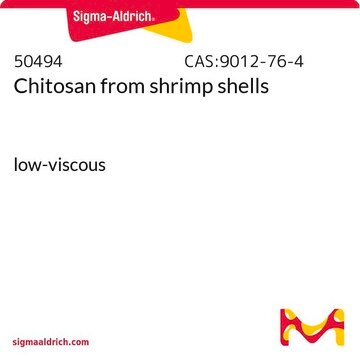This product is not considered a low molecular weight option. The material is a fairly crude, practical grade. Historical data indicates an estimated molecular weight range of 190 - 375 kDa.
C3646
Chitosan
from shrimp shells, ≥75% (deacetylated)
Synonyme(s) :
Deacetylated chitin, Poly(D-glucosamine)
Sélectionner une taille de conditionnement
72,90 $
Sélectionner une taille de conditionnement
About This Item
72,90 $
Produits recommandés
Source biologique
shrimp shells
Niveau de qualité
Essai
≥75% (deacetylated)
Forme
powder or flakes
Couleur
white to beige
Pf
102.5 °C ((216.5 °F ))
Solubilité
acetic acid: water: 10 mg/mL, slightly hazy to hazy (with extensive sonication)
H2O: insoluble
organic solvents: insoluble
Masse volumique apparente
0.15‑0.3 g/cm3
Température de stockage
room temp
Chaîne SMILES
N([C@H]1[C@@H](O[C@@H]([C@H]([C@@H]1O)O[C@@H]4O[C@@H]([C@H]([C@@H]([C@H]4N)O)O[C@@H]5O[C@@H]([C@H]([C@@H]([C@H]5N)O)O[C@@H]6O[C@@H]([C@H]([C@@H]([C@H]6N)O)O[C@@H]7O[C@@H]([C@H]([C@@H]([C@H]7N)O)O[C@@H]8O[C@@H]([C@H]([C@@H]([C@H]8N)O)O[C@@H]9O[C@@H]([C@H](
InChI
1S/C56H103N9O39/c1-87-56(86)65-28-38(84)46(19(10-74)96-55(28)104-45-18(9-73)95-49(27(64)37(45)83)97-39-12(3-67)88-47(85)20(57)31(39)77)103-54-26(63)36(82)44(17(8-72)94-54)102-53-25(62)35(81)43(16(7-71)93-53)101-52-24(61)34(80)42(15(6-70)92-52)100-51-23(60)33(79)41(14(5-69)91-51)99-50-22(59)32(78)40(13(4-68)90-50)98-48-21(58)30(76)29(75)11(2-66)89-48/h11-55,66-85H,2-10,57-64H2,1H3,(H,65,86)/t11-,12-,13-,14-,15-,16-,17-,18-,19-,20-,21-,22-,23-,24-,25-,26-,27-,28-,29-,30-,31-,32-,33-,34-,35-,36-,37-,38-,39-,40-,41-,42-,43-,44-,45-,46-,47-,48+,49+,50+,51+,52+,53+,54+,55+/m1/s1
Clé InChI
FLASNYPZGWUPSU-SICDJOISSA-N
Vous recherchez des produits similaires ? Visite Guide de comparaison des produits
Application
Caractéristiques et avantages
Qualité
Notes préparatoires
Remarque sur l'analyse
Autres remarques
Code de la classe de stockage
11 - Combustible Solids
Classe de danger pour l'eau (WGK)
nwg
Point d'éclair (°F)
Not applicable
Point d'éclair (°C)
Not applicable
Équipement de protection individuelle
Eyeshields, Gloves, type N95 (US)
Faites votre choix parmi les versions les plus récentes :
Certificats d'analyse (COA)
Vous ne trouvez pas la bonne version ?
Si vous avez besoin d'une version particulière, vous pouvez rechercher un certificat spécifique par le numéro de lot.
Déjà en possession de ce produit ?
Retrouvez la documentation relative aux produits que vous avez récemment achetés dans la Bibliothèque de documents.
Articles
Carcinogenic compounds in elastomers: 1,3-butadiene and isoprene used in elastomer manufacturing, classified as carcinogenic by IARC.
-
C3646 chitosan is lower molecular weight? What is the molecular weight range?
1 answer-
Helpful?
-
-
How can I determine the shelf life / expiration / retest date of this product?
1 answer-
If this product has an expiration or retest date, it will be shown on the Certificate of Analysis (COA, CofA). If there is no retest or expiration date listed on the product's COA, we do not have suitable stability data to determine a shelf life. For these products, the only date on the COA will be the release date; a retest, expiration, or use-by-date will not be displayed.
For all products, we recommend handling per defined conditions as printed in our product literature and website product descriptions. We recommend that products should be routinely inspected by customers to ensure they perform as expected.
For products without retest or expiration dates, our standard warranty of 1 year from the date of shipment is applicable.
For more information, please refer to the Product Dating Information document: https://www.sigmaaldrich.com/deepweb/assets/sigmaaldrich/marketing/global/documents/449/386/product-dating-information-mk.pdfHelpful?
-
-
How is shipping temperature determined? And how is it related to the product storage temperature?
1 answer-
Products may be shipped at a different temperature than the recommended long-term storage temperature. If the product quality is sensitive to short-term exposure to conditions other than the recommended long-term storage, it will be shipped on wet or dry-ice. If the product quality is NOT affected by short-term exposure to conditions other than the recommended long-term storage, it will be shipped at ambient temperature. As shipping routes are configured for minimum transit times, shipping at ambient temperature helps control shipping costs for our customers. For more information, please refer to the Storage and Transport Conditions document: https://www.sigmaaldrich.com/deepweb/assets/sigmaaldrich/marketing/global/documents/316/622/storage-transport-conditions-mk.pdf
Helpful?
-
-
What is the Department of Transportation shipping information for this product?
1 answer-
Transportation information can be found in Section 14 of the product's (M)SDS.To access the shipping information for this material, use the link on the product detail page for the product.
Helpful?
-
-
What is the molecular weight of Product C3646, Chitosan from shrimp shells?
1 answer-
Sigma-Aldrich has not determined an average molecular weight or a molecular weight range for this product.
Helpful?
-
-
Is Product C3646, Chitosan from shrimp shells, USP grade?
1 answer-
No, this product is not considered USP grade.
Helpful?
-
-
What is the pKa of Product C3646, Chitosan from shrimp shells?
1 answer-
The amino group in chitosan has a pKa value of ~6.5.
Helpful?
-
Active Filters
Notre équipe de scientifiques dispose d'une expérience dans tous les secteurs de la recherche, notamment en sciences de la vie, science des matériaux, synthèse chimique, chromatographie, analyse et dans de nombreux autres domaines..
Contacter notre Service technique




